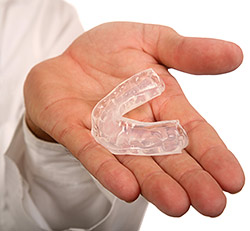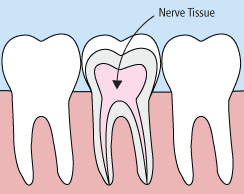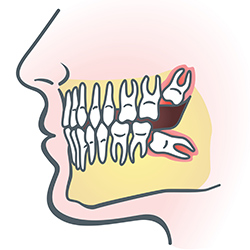Topics on this page
Regular Exams and Dental Cleanings
Regular exams are vital for maintaining your child's oral health. During these exams, we will:
- Check for any underlying issues
- Look for cavities and signs of decay
- Examine the teeth and gums for gingivitis or periodontal disease
- Conduct a thorough teeth cleaning
These exams typically last about 30 minutes and include a detailed cleaning to remove tartar and plaque buildup.
Visiting our office every six months provides the best chance to keep your child's oral health in check. Regular exams and dental cleanings are available by appointment only, so please contact our Colorado Springs practice today to schedule your child's next dental exam and cleaning.
Bonding
 Bonding, or often called a "white filling," is a conservative approach to fix slightly chipped, discolored, or misaligned teeth. During this procedure, a white filling is applied to your child's tooth, enhancing its appearance. This filling "bonds" with the tooth and comes in various tooth-colored shades, closely resembling natural teeth.
Bonding, or often called a "white filling," is a conservative approach to fix slightly chipped, discolored, or misaligned teeth. During this procedure, a white filling is applied to your child's tooth, enhancing its appearance. This filling "bonds" with the tooth and comes in various tooth-colored shades, closely resembling natural teeth.
It can also replace silver fillings, with many patients favoring bonded fillings due to their less noticeable white color. They're suitable for both front and back teeth, depending on the location and extent of decay.
While bonding is a cost-effective option and can usually be completed in a single visit, it may stain and is more prone to breakage compared to porcelain veneers. Should any breakage occur, inform your dentist, as bonding can typically be promptly patched or repaired in one visit.
Crowns
 Crowns are a restorative treatment used to enhance a tooth's shape or reinforce its structure, particularly for teeth that are broken, worn, or affected by decay.
Crowns are a restorative treatment used to enhance a tooth's shape or reinforce its structure, particularly for teeth that are broken, worn, or affected by decay.
A crown, also known as a "cap," is cemented onto an existing tooth, covering the portion above the gum line and serving as the tooth's new outer surface. Crowns can be crafted from porcelain, metal, or a combination of both, with porcelain crowns often preferred for their natural appearance and strength.
When there isn't enough tooth strength to support a filling, crowns or onlays (partial crowns) are necessary. Unlike fillings applied directly into the mouth, for children, crowns are pre-fabricated outside the mouth. Our pediatric office will have a selection of crowns that will be the "perfect fit" for your child based on your child's unique tooth, ensuring proper fit and function to restore normal bite and jaw movements. Crowns come in two options: stainless steel or a white porcelain. Please inquire about both.
Extractions
 There are occasions when tooth removal or an "extraction" becomes necessary. For instance, a baby tooth may have misshapen or long roots, impeding its natural shedding process, requiring extraction to pave the way for permanent tooth eruption. Alternatively, severe decay jeopardizing surrounding teeth may warrant removal to prevent further decay risk. Infection, orthodontic adjustments, or wisdom tooth complications can also necessitate tooth removal.
There are occasions when tooth removal or an "extraction" becomes necessary. For instance, a baby tooth may have misshapen or long roots, impeding its natural shedding process, requiring extraction to pave the way for permanent tooth eruption. Alternatively, severe decay jeopardizing surrounding teeth may warrant removal to prevent further decay risk. Infection, orthodontic adjustments, or wisdom tooth complications can also necessitate tooth removal.
When a tooth extraction is deemed necessary, Dr. Sean may perform the procedure during a regular checkup or schedule a separate visit. Same day visits are readily available if an emergency is necessary. Each tooth's root is nestled within the jawbone in a tooth socket, held in place by a ligament. To "wiggle out" a tooth, Dr. Sean must delicately widen the socket and "slip" the tooth from the ligament. Although typically swift, it's important to discuss any concerns or sedation preferences with our office beforehand.
Fillings
 Traditional dental restoratives, such as fillings, may consist of materials like amalga, porcelain, or composite. Modern options also include ceramic and plastic compounds that closely resemble natural teeth. Known as composite resins, these materials are commonly used on visible front teeth to maintain a natural appearance. Our office only uses the safest white composite restorations.
Traditional dental restoratives, such as fillings, may consist of materials like amalga, porcelain, or composite. Modern options also include ceramic and plastic compounds that closely resemble natural teeth. Known as composite resins, these materials are commonly used on visible front teeth to maintain a natural appearance. Our office only uses the safest white composite restorations.
Fluoride
 Fluoride is highly effective in preventing cavities, tooth decay, and the buildup of hardened plaque on teeth. Administered during a dental cleaning office visit, a fluoride treatment is a brief procedure lasting just a few minutes. Afterward, your child may be instructed to avoid rinsing, eating, or drinking for at least 10 minutes to allow fluoride absorption by the teeth. Sometimes, our office will instruct you not even to brush your teeth for that evening! The frequency of fluoride treatments, whether every three, six, or 12 months, is determined based on your child's oral health status or Dr. Sean's professional recommendations.
Fluoride is highly effective in preventing cavities, tooth decay, and the buildup of hardened plaque on teeth. Administered during a dental cleaning office visit, a fluoride treatment is a brief procedure lasting just a few minutes. Afterward, your child may be instructed to avoid rinsing, eating, or drinking for at least 10 minutes to allow fluoride absorption by the teeth. Sometimes, our office will instruct you not even to brush your teeth for that evening! The frequency of fluoride treatments, whether every three, six, or 12 months, is determined based on your child's oral health status or Dr. Sean's professional recommendations.
Mouthguards
 Protecting your child's smile during sports activities is crucial, whether they wear braces or not. Mouthguards play a vital role in safeguarding teeth and gums from injury. If your child engages in full-contact sports, the American Dental Association recommends the use of a mouthguard.
Protecting your child's smile during sports activities is crucial, whether they wear braces or not. Mouthguards play a vital role in safeguarding teeth and gums from injury. If your child engages in full-contact sports, the American Dental Association recommends the use of a mouthguard.
It's important to choose the right type of mouthguard, which typically falls into three categories: pre-made, "boil-and-bite" fitted, or custom-made by a lab. When selecting a mouthguard, prioritize options that are tear-resistant, comfortable, well-fitted, easy to clean, and allow proper breathing. Dr. Sean can guide your child on proper mouthguard usage and help choose the most suitable one for protecting their smile.
Nightguards
 If your child frequently wakes up with jaw pain, earaches, or headaches, or if you notice them clenching or grinding their teeth, they may have a common condition known as “bruxism”. Teeth grinding often occurs during sleep, and many people are unaware of it. If left untreated, bruxism can result in broken, cracked, or lost teeth.
If your child frequently wakes up with jaw pain, earaches, or headaches, or if you notice them clenching or grinding their teeth, they may have a common condition known as “bruxism”. Teeth grinding often occurs during sleep, and many people are unaware of it. If left untreated, bruxism can result in broken, cracked, or lost teeth.
Fortunately, there's a simple, non-invasive treatment for bruxism: nightguards. These custom-made devices, crafted by a dentist from soft material to fit your child's teeth, are inserted over either the top or bottom arch. Nightguards prevent contact between the opposing teeth, effectively preventing the wear and damage caused by teeth grinding over time.
Root Canals
 In the past, a permanent tooth with a diseased nerve often resulted in tooth loss for your child. However, with the advancement of dental care, a procedure called “root canal treatment” now offers the possibility of saving the tooth. When a tooth is cracked or has a deep cavity, bacteria can penetrate the pulp tissue, leading to infection. Untreated infections may result in an abscess, causing pain, swelling, and potential damage to the jawbones and overall health.
In the past, a permanent tooth with a diseased nerve often resulted in tooth loss for your child. However, with the advancement of dental care, a procedure called “root canal treatment” now offers the possibility of saving the tooth. When a tooth is cracked or has a deep cavity, bacteria can penetrate the pulp tissue, leading to infection. Untreated infections may result in an abscess, causing pain, swelling, and potential damage to the jawbones and overall health.
Root canal treatment typically requires one to three visits. Our office may need to refer you out to a specialist. During the procedure, the dental specialist removes the infected tissue, cleans and seals the interior of the tooth, and fills it with dental composite. In cases of extensive decay, a crown may be recommended to strengthen and protect the tooth from breakage. With proper oral care, including regular brushing, flossing, and checkups, the restored tooth can last a lifetime.
Sealants
 At times, simply brushing isn't sufficient, particularly when dealing with those hard-to-reach areas within your child’s mouth. The small cracks and grooves on your child’s teeth pose a challenge for conventional toothbrushes. Left unaddressed, these minute spaces can lead to tooth decay. Sealants offer an additional layer of defense against decay and cavity formation for your child’s teeth.
At times, simply brushing isn't sufficient, particularly when dealing with those hard-to-reach areas within your child’s mouth. The small cracks and grooves on your child’s teeth pose a challenge for conventional toothbrushes. Left unaddressed, these minute spaces can lead to tooth decay. Sealants offer an additional layer of defense against decay and cavity formation for your child’s teeth.
Dental sealants consist of a plastic resin that adheres and solidifies within the deep grooves on your child’s tooth surfaces. Sealing a tooth results in smoothing out these tiny crevices, reducing the likelihood of plaque accumulation. With sealants in place, brushing your child's teeth becomes more manageable and more effective in combating tooth decay.
Sealants are typically applied to children’s teeth following the eruption of their permanent dentition as a preventative measure against tooth decay. While it's more common to seal "permanent" teeth rather than "baby" teeth, individual patient needs vary, and your child’s dentist will tailor recommendations accordingly.
The lifespan of sealants ranges from three to six years, though it's quite common to find adults with sealants still intact from their childhood. However, for optimal protection, a dental sealant must remain fully intact. Should your child’s sealants become dislodged, promptly inform your dentist and schedule an appointment for re-sealing your child's teeth.
Veneers
 Your child no longer needs to feel self-conscious about gaps, chips, stains, or misshapen teeth affecting their smile. Veneers offer a simple solution to correct these imperfections, helping your child achieve a more confident and beautiful smile. Natural in appearance, veneers are an ideal choice for patients seeking minor adjustments to their smile's look and feel.
Your child no longer needs to feel self-conscious about gaps, chips, stains, or misshapen teeth affecting their smile. Veneers offer a simple solution to correct these imperfections, helping your child achieve a more confident and beautiful smile. Natural in appearance, veneers are an ideal choice for patients seeking minor adjustments to their smile's look and feel.
Veneers are thin, custom-made shells crafted from tooth-colored materials like porcelain, designed to cover the front surface of your child's teeth. To begin the process, a dentist creates a unique model of your child’s teeth, which is then sent to a dental technician to fabricate the veneers. Before placement, the dentist may need to prepare the tooth conservatively to achieve the desired aesthetic result.
Once in place, you'll be pleased to see that veneers closely resemble your child's natural teeth. While veneers are stain-resistant, the dentist may recommend that your child avoids certain staining food and drinks to maintain the beauty of their new smile.
Most often, the timing of a veneer is during the late teenage years to allow full eruption of the tooth. Dr. Sean will offer several options for younger patients before they are ready for veneers.
Wisdom Teeth
 Wisdom teeth are molars located at the very back of your child’s mouth, typically emerging in the late teens or early 20s. However, they may become impacted (fail to erupt) due to limited jaw space or their angle of entry. Impacted wisdom teeth can cause gum tenderness, swelling, or severe pain if left untreated. They are also difficult to clean and prone to decay, infections, and gum disease.
Wisdom teeth are molars located at the very back of your child’s mouth, typically emerging in the late teens or early 20s. However, they may become impacted (fail to erupt) due to limited jaw space or their angle of entry. Impacted wisdom teeth can cause gum tenderness, swelling, or severe pain if left untreated. They are also difficult to clean and prone to decay, infections, and gum disease.
Wisdom teeth are often removed during late teens or early twenties when their roots are not fully formed, and the surrounding bone is less dense, making extraction easier and shortening recovery time. For difficult removal, our office will refer you to a dental specialist.
To remove a tooth, Dr. Sean numbs the area with local anesthetic. If the tooth is impacted then it may need to be "sectioned" or split into smaller pieces for easier extraction. After extraction, the healing process begins, with recovery time varying based on the extraction difficulty. Our office will provide instructions for a comfortable and efficient healing process.


